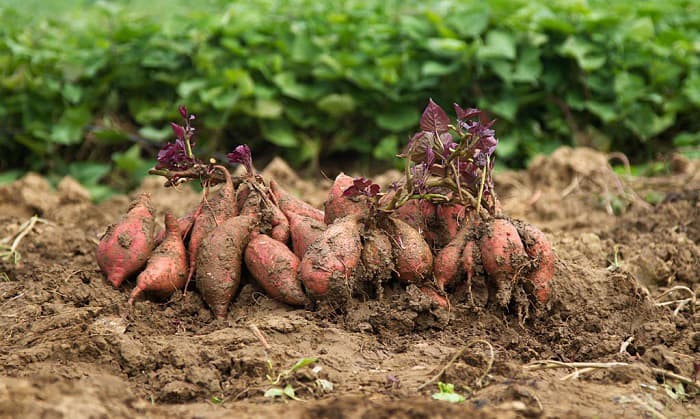In 2020, Florida ranked sixth in the US for the production of sweet potatoes, proving just how much the state’s warm climate suits these tubers.
Not only are sweet potatoes delicious, but they’re also rich in vitamins and minerals, making them an excellent choice for health-conscious gardeners.
So, how to grow sweet potatoes in Florida? We have just the tips to help you do this task.
Table of Contents
What You Need
Before planting sweet potatoes, you should prepare the following:
- Sandy soil with good drainage and a pH of8 to 6.0 (an acidity level of 5.5 to 6.8 is acceptable)
- Compost and fertilizer
Pick a low-nitrogen compost and fertilizer, either store-bought or homemade. Before purchasing the latter, conduct a soil test and see how many pounds of nitrogen, phosphate, and potassium are necessary.
In practice, the nutritional ratio of the fertilizer should match that of the soil test. For instance, gardeners who need a 5-10-10 fertilizer can use a 10-20-20 formula.
Once you’ve determined the fertilizer type, calculate how much of it you need to buy through the following steps:
- First, divide the pounds of nitrogen the soil test recommends by the nitrogen amount in your fertilizer (measured in decimals).
- Second, divide the area of your garden (in square feet) by 1000.
- Finally, multiply the results of the previous equations to get the total pounds of fertilizer.
- Sweet potato slips
People don’t really grow sweet potatoes from seeds. Instead, they use slips or small transplants with roots and leaves, and we recommend you do so as well.
When buying transplants, make sure they are disease-free. It is also best to give the slip roots moisture the minute you receive them, especially if the ground isn’t ready for sowing yet. You can also store them in a warm nursery bed or organic potting mix until planting.
- Water hose or can
- Shovel – We’ll use this to till and dig the soil.
Steps for Growing Sweet Potatoes in Florida
Step 1: Prepare the planting location
Because sweet potatoes need full sun, ensure the garden bed gets six to eight hours of sunlight per day. I also recommend removing weeds, rocks, and other obstacles from the soil before planting.
Once the garden is clear of all detritus, apply compost or fertilizer to it at a depth of eight to twelve inches. Then, create soil mounds with heights of eight inches, though you can go for twelve inches if you want, to keep sweet potatoes from rotting.
If you have multiple garden rows or beds, they should be three feet apart, and for ideal plant spacing, the same distance should apply to the mounds. If this is not possible, aim for at least 10 to 18 inches of space between mounds.
Step 2: Plant sweet potatoes
At this point, you can start growing sweet potatoes. But when do you plant them? In Florida, the sweet potato planting season is in spring, 3-4 weeks after the last frost.
The best time to transplant the slips is the evening when the soil is 60 to 85 degrees Fahrenheit. Note that temperatures above 100 degrees will cause delayed growth, wilting, and even plant death.
With that in mind, place the potato slips into the mounds horizontally. Usually, a transplant depth of 3 to 6 inches will do, but you can perform an eye test to make things easy. As long as the foliage receives sunlight and the roots entrench themselves into the ground, you’re good to go.
Moreover, pay attention to the slip spacing as well. You should plant sweet potatoes 12 inches apart so that they have room to spread and not compete with each other. Lastly, pat the soil firmly to prevent air pockets.
Step 3: Care for the plants
To help them establish, give sweet potatoes two inches of water for the first week of planting. You can reduce irrigation to one inch per week after the slips have taken root.
Aside from frequent watering, be mindful of the six-to-eight-weeks mark after transplanting. At this point, give the ground an inch of compost to help potato vines grow.
Last but not least, keep an eye out for weeds and cease watering a month before harvest.
FAQs
Are sweet potato leaves poisonous?
No, they aren’t. You can saute, boil, juice, and even eat them raw. Sweet potato leaves contain a lot of fiber and vitamins, so they’re actually quite healthy.
Can sweet potatoes grow year-round in Florida?
The answer depends on where you live. If there’s frost in your area, then no, sweet potatoes cannot grow all year.
In central Florida, for instance, frosts will still appear during the cold season, however rare they may be. Meanwhile, in south Florida, temperatures often don’t dip below 40 degrees Fahrenheit, so planting sweet potatoes year-around may be possible here.
When to harvest sweet potatoes in Florida?
Sweet potatoes are harvestable three to four months after planting. Suppose you start the transplant in February or March, which is often the case in Florida, you can collect your tubers in July or June.
That said, it’s best to check your cultivar for an accurate prediction. For example, Vardaman sweet potatoes will mature in 100 days, while Beauregard tubers will take less time to grow (about 90 days). You can add these numbers to your transplant date to determine harvest time.
How many sweet potatoes per plant?
Typically, gardeners can expect three tubers per plant, with ten being the maximum number. If you’re after high yields, go for vining varieties that grow on trellises instead of bush type sweet potatoes.
However, if you have little space for gardening, bush varieties will fit in containers and bags much more easily.
In addition, if you are interested in planting potatoes in other states, don’t forget to learn our articles:
- Best time to plant potatoes in Michigan
- When to plant potatoes in North Carolina
- The most suitable time to plant potatoes in zone 7
Conclusion
Hopefully, you now know how to grow sweet potatoes in Florida. Keep in mind the tips we shared above, and pick cultivars that suit the state climate for ideal growth.
For example, Boniato, Burgundy, and Palmetto are varieties recommended by the University of Florida, so they’re certainly worth a try.
If you have any questions about this topic, feel free to contact us. Thank you for reading.

Hi, I am William – Floridayards’ digital content creator. My job is to find answers to all your concerns with thorough research and our team’s expert advice. I will also bring you honest reviews on the best products and equipment for raising your beautiful garden. Please look forward to our work!














